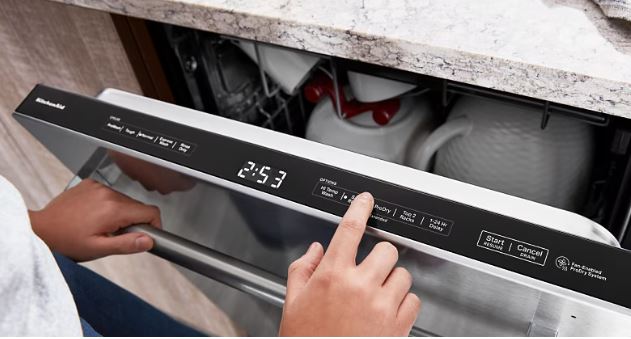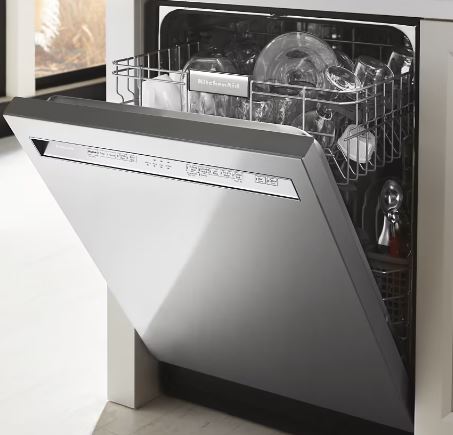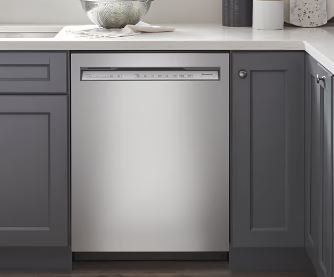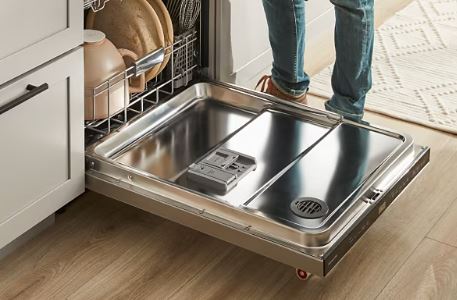Not every time a Kitchenaid dishwasher malfunctions that you should call the repairer or manufacturer. Sometimes, all you’ve to do is run the Kitchenaid dishwasher diagnostic mode, which allows you to find hidden error codes, which enables you to know what’s wrong with your dishwasher and possibly troubleshoot it.
You can put your Kitchenaid dishwasher on diagnostic mode by pressing any of these buttons while on standby mode: First three buttons, Heated-Dry + Normal, High-Temp Scrub + Air-Dry, Sani-Rinse – Air-Dry, High-Temp Wash, Rinse-Only + SANI Rinse, or High-Temp Wash + Energy-Saver Dry.
Overall, the diagnostic technique depends on the dishwasher model, and I’ll share more details later. I’ll also explain how to put your dishwasher on standby mode, as it’s a critical step.
Another thing to note is that you may need to press those buttons more than once to enter the diagnostic, and I’ll also explain what to do precisely. Last, we’ll discuss the error codes, especially their meaning and triggers, and how to reset them.
So, let’s dive in!

In a hurry? Below is an overview of how to enter a Kitchenaid dishwasher into diagnostic mode:
Kitchenaid Dishwasher Diagnostic Mode Techniques Summary
| – | Keys to Press | Preferred Kitchenaid Dishwasher Model |
| 1. | First three buttons in three repetitions while on standby | Kitchenaid W10195615A dishwasher |
| 2. | Heated-Dry + Normal twice while on standby | Kitchenaid 8572216, W10142800B, and W10130990C dishwashers |
| 3. | High-Temp Scrub + Air Dry twice while on standby | Kitchenaid 8537797 dishwashers |
| 4. | Sani-Rinse + Air-Dry | Kitchenaid 8537797 dishwashers |
| 5. | High-Temp Wash 6 times while on standby mode | Kitchenaid KUDD03DT dishwashers |
| 6. | Rinse-Only + SANI Rinse twice while on standby mode | Kitchenaid KIDS01EK dishwashers |
| 7. | High-Temp Wash + Energy-Saver Dry twice while on diagnostic mode | Kitchenaid KUDR245EWH5 dishwashers |
How Do I Run a Diagnostic On My Dishwasher?
Kitchenaid dishwashers aren’t the same. They differ in model number, so you cannot run diagnostics on them similarly. Some diagnostic techniques may work on some models and fail on others.
Depending on the model, here’s how to put Kitchenaid dishwasher on diagnostic mode:
1st Option: First Three Keypad Buttons
(Best for Model W10195615A)
If you have a Kitchenaid W10195615A dishwasher, you can try putting it on diagnostic mode using these steps:
- Put the dishwasher on standby mode – which is to leave it unplugged (in the wall socket) but not turned on
- Identify the first three buttons on the keypad and press them one after the other once
- Repeat the sequence twice to complete a 3-cycle sequence, and that’ll enable the dishwasher to enter into diagnostic mode
- Wait for the dishwasher to flash an error code, which you should note down and check out its meaning
2nd Option: Heated-Dry + Normal
(Best for Models 8572216, W10142800B, and W10130990C)
Consider putting your Kitchenaid dishwasher on diagnostic mode using this technique if it’s of model number 8572216, W10142800B, and W10130990C. Here’s how to do it:
- Put the dishwasher on standby mode
- Identify the Heated-Dry and Normal buttons on the keypad and press them simultaneously
- Wait for a second or so and press the two buttons again to enter diagnostic mode
- Ensure you complete the quick steps in under 6 seconds to enter the diagnostic successfully
- Note down any error code that pops up
3rd Option: High-Temp Scrub + Air Dry
(Best for Model 8537797)
A Kitchenaid 8537797 dishwasher needs a rather different diagnostic technique. One of them involves these steps:
- Put the dishwasher on standby mode
- Identify the High-Temp Scrub and Air Dry buttons and press them simultaneously
- Wait for a second or so to press them again
- Ensure you complete the quick steps within 6 seconds to enter diagnostics successfully
- Note down any fault code that may pop up

4th Option: Sani-Rinse + Air-Dry
(Best for Model 8537797)
Generally, there is more than one way to reset the Kitchenaid 8537797 dishwasher. One is what I’ve shared above, and the other involves pressing Sani Rinse instead of High-Temp Scrub. The process is, however, the same as above.
5th Option: High Temp Wash
(Best for KUDD03DT)
If your Kitchenaid dishwasher has the High Temp Wash button on the keypad, which is most likely to be the case if it’s the model number KUDD03DT, consider putting it on diagnostic mode using these steps:
- First, put the dishwasher on standby mode
- Identify the High Temp wash button and press it six times
- Ensure you do everything within 10 seconds to enter the service mode successfully
- Wait for a fault code to pop up and note it down
6th Option: Rinse-Only + SANI Rinse
(Best for KIDS01EK)
Some Kitchenaid dishwashers have the Rinse-Only and SANI Rinse buttons, especially the model number KIDS01EK. If that’s the case, you can enter it into diagnostic mode using these quick steps:
- First, put your dishwasher on standby mode
- Identify the Rinse-Only and SANI Rinse buttons on the keypad and press them once
- Press the two buttons again to enter the dishwasher into diagnostic mode
- Wait for a few seconds for the dryer to display an error code if there’s a fault
7th Option: High-Temp Wash + Energy-Saver Dry
(Best for KUDR245EWH5)
Perhaps your dryer has the High-Temp Wash and Energy-Saver Dry buttons, which happens to be the case of the model number KUDR245EWH5. If that’s so, here’s how to put it into diagnostic mode:
- Start by placing the dishwasher on standby mode
- Identify the High-Temp Wash and Energy-Saver Dry buttons on the keypad and press the two simultaneously
- Wait for a second or so and press them again to enter diagnostic mode
- Ensure you complete the button-pressing within 10 seconds to enter the dishwasher into diagnostics successfully
- Wait to note down any error code that may appear
How Do You Reset Kitchenaid Dishwasher?
You’ll notice that I’ll recommend a reset to most Kitchenaid dishwasher error codes. So, how about we discuss how to do it now? Here’s how to quickly reset your Kitchenaid dishwasher:
- Plug out the dishwasher from the wall socket
- Wait for 1-5 minutes to plug it back in
- Power it on to see if the error code is still there
- If it is, flip off the circuit breaker for the dishwasher for at least 1 minute
- Then flip the breaker back on and power on the dishwasher

Kitchenaid Dishwasher Diagnostic Codes
You’ll most likely get an error code after a successful diagnostic. If that’s the case, knowing its meaning and possibly troubleshooting it is essential.
Here are the commonest Kitchenaid dishwasher error codes and their troubleshooting:
1. Error Code E3, F4E3, F2E2, F2E3, E6E7, and F8E2
(Meaning – The dishwasher needs a power reset)
The error codes E3, F4E3, F2E2, F2E3, E6E7, or F8E2 will likely appear when there’s a power glitch, which calls for a reset.
Fix
Just plug the dishwasher out for 1-5 minutes, and the error should disappear.
2. Error Code F6E1
(Meaning – Dishwasher won’t start)
The error code F6E1 appears when your Kitchenaid dishwasher has issues starting. It could be that the dishwasher won’t start at all or it’s unable to resume a cycle.
Fix
You can fix this error code by resetting the dishwasher like the first batch.
3. Error Code E1
(Meaning – Dishwasher is siphoning)
The error code E1 pops up on a Kitchenaid dishwasher when the dishwasher siphons. This could happen due to the wrong drain hose height (perhaps lower than 20 inches), the water supply being off, or an obstructed overfill protection.
Fix
Ensure the water supply is turned on and unstick the overfill protection if stuck. Don’t forget to check the drain hose and ensure it’s at least 20 inches high.
4. Error Code F6E3
(Meaning – Excess suds)
If there are too many suds, you can expect the fault code F6E3 to appear on a Kitchenaid dishwasher. That happens when you use too much detergent or perhaps the wrong type. Sometimes, however, it may be a case of not changing the rinse aid dispenser cap after refilling the rinse aid.
Fix
Ensure you only use the recommended dishwashing detergent and use it in the correct amount. Moreover, replace the rinse aid dispenser cap after a rinse aid refill.
5. Error Code F6E4
(Meaning – Unlevelled dishwasher)
You can expect the error code F6E4 to pop up on your Kitchenaid dishwasher if the dishwasher is off balance. This could be a case of an uneven floor or loose feet.
Fix
Ensure the dishwasher rests on even ground and adjust its feet if they are loose to clear the error code.

6. Error Code F9E1 or F9E2
(Meaning – Drainage fault)
The error code F9E1 or F9E2 appears when there’s a drainage fault. That could be a result of failing to remove the garbage disposal cap. Another issue that could trigger this drainage fault code is a kinked or obstructed drain hose.
Fix
Remove the knockout plug and clear any kinks and clogs from the drain hose.
7. Error Code H20
(Meaning – Paused cycle)
The error code H20 on a Kitchenaid dishwasher suggests a paused cycle. Often, this results from water supply interruption. It could be that the water supply is suddenly off or a kinked water supply hose.
Fix
Ensure the water supply is on and remove any kinks and bends from the water supply hose.
8. Error Code F1E1
(Meaning – Stuck relay on the ECB)
The Kitchenaid dishwasher may present the error code F1E1 if there’s a stuck relay on the ECB (Electronic Control Board).
Fix
Try to reset the dishwasher to see if the fault code will disappear. If it doesn’t, call Kitchenaid.
9. Error Code F1E2
(Meaning – Corrupted control board memory)
If an issue with the control board requires a reset, the error code F1E2 may appear.
Fix
Reset the dishwasher to reset the control board’s memory eventually.
10. Error Code F6E1
(Meaning – Water filling difficulty)
If your Kitchenaid dishwasher doesn’t fill up with water, the error code F6E1 may pop up. It could result from a disconnected water supply, a clogged water inlet valve, or stuck overfill protection.
Fix
Ensure your dishwasher gets water. The supply line should be turned on, and the water inlet valve and overfill protection should be free from obstruction.
Concluding Thought on the Kitchenaid dishwasher diagnostic mode:
Above are the seven techniques you can apply to put your Kitchenaid dishwasher in diagnostic mode. Even better, you have a quick guide to troubleshooting the most typical error codes that may pop up. Do that before calling Kitchenaid or spending money on an expert.
